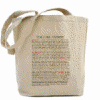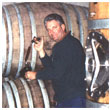
We're an all volunteer website and need your help to keep going. Here are five ways you can contribute: 1 Donate 2 Buy something 3 Submit a story 4 Volunteer 5 Advertise

New in the gift shop, virtualitalia.com logo wear and use items! 
|
PLEASE NOTE: We are experiencing unexpected
technical difficulties caused by our web host. We apologize for
the inconvenience. During your visit you may experience service
and page interruptions - we are in the process of fixing everything and hope to be
fully back on our feet soon.
[an error occurred while processing this directive]
grape leaves
Grapes need abundant exposure to sunlight and fresh air in order to develop their best flavors. That's the main reason we train the shoots of the vine upward, so that the fruit hangs down below the leaves where it can catch a lot of sun. All of this time-consuming training would be for naught, however, if we allowed too many leaves to flourish up top. Let me explain. Years of grape-growing have taught us that although leaves are necessary for absorbing sunlight, they also sap energy from the vine - energy that is needed by the grapes. So it is critical to allow only those leaves to remain that are actively contributing to the vitality of the vine. Using light sensitivity meters, researchers have determined that 90% of the sunlight that benefits the vine is absorbed by the first layer of leaves. The second layer absorbs about 7% and the third layer absorbs just 3% or less. You don't need a degree in math to conclude that the third layer isn't contributing its fair share. In fact, it's pretty safe to say that these free-loaders are probably sapping energy from the vine that would be better spent on the grapes. So each May, our crews fan out through the vineyards, twisting the third layers of leaves from the grapevines and tossing them on the ground where they will eventually decompose. As they move among the vines, they also remove any wayward leaves - regardless of layer - that might possibly shield the grape clusters from the sunlight. Leaf-pulling not only helps the vigor of the vines and allows sunlight to reach the grapes, it also enables fresh air to flow more freely among the grape clusters. And we know from experience that good air circulation significantly reduces the chances of mold growing on the fruit. Pulling leaves by hand may sound like a lot of tedious work, and it is. But the difference that leaf-pulling makes in the quality of the grapes we harvest is absolutely phenomenal. Grapes that are exposed to abundant sunlight have much better color and flavor. Sunlight lowers the pH and lowers levels of malic acid (the bad acid) while increasing total acidity in the grapes. In short, it makes our work as winemakers a heck of a lot easier since we've got a better quality product to work with. The most important component in a fine wine isn't barrels or bottles but premium quality grapes. And thanks to revolutionary new vineyard management techniques such as leaf-pulling, great grapes are getting easier to come by.
about the author |
© 1998-2005 by virtualitalia.com unless otherwise noted
 Leaves are lovely to look at, but allow too many to thrive on a grapevine and you run the risk of harvesting less-than-perfect fruit.
Leaves are lovely to look at, but allow too many to thrive on a grapevine and you run the risk of harvesting less-than-perfect fruit.
 A third-generation Sonoma Valley winemaker, Sam Sebastiani was born and raised in the heart of Sonoma. He spent his early years learning viticulture and enology from his father, August Sebastiani (1913-1980), a renowned California winemaker.
Founded in 1989 by Sam and Vicki Sebastiani, Viansa is their vehicle to share their love of good food, wine and their Italian heritage with visitors from around the world. Dedicated to the marriage of wine and food, Viansa (short for "Vicki and Sam") offers visitors a taste of Tuscany in Sonoma Valley. Today, this family-owned and operated winery is proud to be the premier producer of Italian varietals in the United States!
A third-generation Sonoma Valley winemaker, Sam Sebastiani was born and raised in the heart of Sonoma. He spent his early years learning viticulture and enology from his father, August Sebastiani (1913-1980), a renowned California winemaker.
Founded in 1989 by Sam and Vicki Sebastiani, Viansa is their vehicle to share their love of good food, wine and their Italian heritage with visitors from around the world. Dedicated to the marriage of wine and food, Viansa (short for "Vicki and Sam") offers visitors a taste of Tuscany in Sonoma Valley. Today, this family-owned and operated winery is proud to be the premier producer of Italian varietals in the United States!